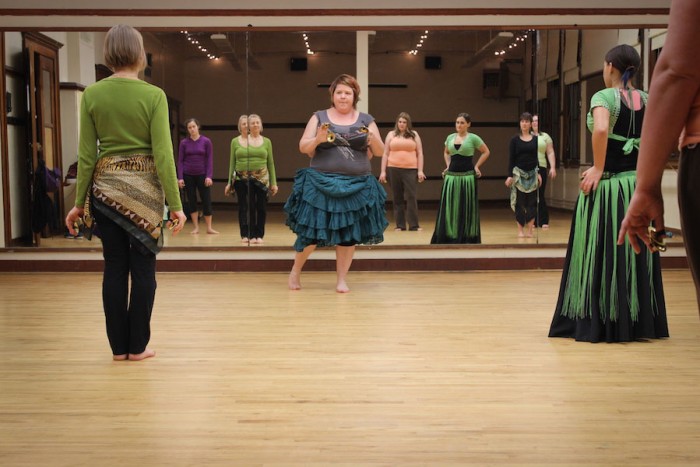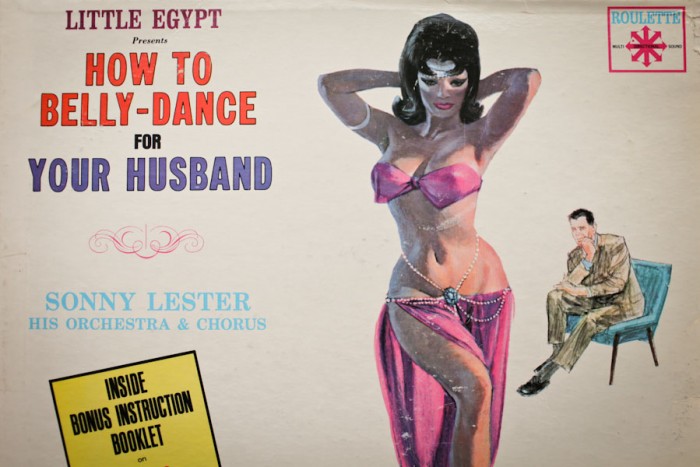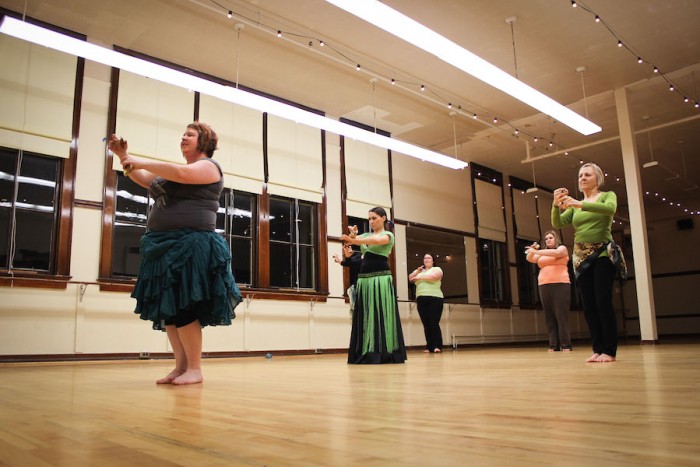
With white skin and a pixie haircut, Shay Moore would probably never be mistaken as an Arab woman.
But come March, she and the troupe of mostly white belly dancers she leads out of her Deep Roots Dance school will be showing off their moves at a belly dance festival in Seattle.
The origins of this style of dancing are much debated. Once known as Raqs sharqi (“Dance of the Orient”), belly dance is often said to have originated in Egypt or Algeria.
At the World Fair in Chicago in the 1893, the hip gyrations of a Middle Eastern dancer were a big hit with the crowds, and the term “belly dance” was coined. Since then trends of orientalized dancing in America have shifted and fused.
“Generally people today would tell you that it’s from Egypt, North African regions in particular. I don’t think anyone would argue that dance today is now a conglomeration of a lot of different cultural sources,” Moore explains, “so even if we could pinpoint the one source it came from, what it looks like today wouldn’t resemble anything like what it was that day.”
In 1987, American Tribal Style Belly Dance — the kind Moore teaches — was created in America as a fusion of dance techniques from North India, the Middle East, and Africa.
Moore says she always had a misconception about belly dance growing up, seeing it as a thing that insecure girls did to show off their bodies. Stereotypical images of belly dance often portray girls in bras and long skirts performing sexy dances for the entertainment of men — much like stripping.

Before Moore opened her own studio in Seattle, she was traveling down to Portland once a week to learn from one of few tribal dance experts in the Pacific Northwest. She fell in love with the dance style in 1998 and saw it’s popularity grow a few years later.
“I think a big boom came 2000 and 2004 maybe where people were like ‘I want to do what Shakira does, where do I do that?’” she says.
But the belly dancing boom in the U.S. has spawned it’s share of critiques. An article published on Salon last year suggested that it was the latest step in a long history of white appropriation of Middle Eastern culture:
“Arab women are not vessels for white women to pour themselves and lose themselves in; we are not bangles or eyeliner or tiny bells on hips. We are human beings. This dance form is originally ours, and does not exist so that white women can have a better sense of community; can gain a deeper sense of sisterhood with each other; can reclaim their bodies; can celebrate their sexualities; can perform for the female gaze.”
A commenter on the article responded saying “…art forms change and grow and multiply into other spaces as they come into the mainstream — you can’t really stop it from happening.”
That seems to characterize Moore’s approach.
She has taken advantage of something that is becoming mainstream and is letting it evolve. She dismisses the criticism saying she teaches dance to celebrate a culture, while mindfully respecting the roots of the dance style.

“We will have people from the Middle East in the audience who will come up in tears and saying ‘that felt like home, I am so excited to see people outside of our culture, taking an interest in our culture,’” she says with pride.
Alessandra Green, another belly dance teacher in Seattle, has a similar perspective:
“Regardless of where an art form may have originated from, I don’t believe that any one country or culture has an exclusive right or ownership over that art form. Art is universal and an expression of our humanity,” Green explained in an email. “As such, I personally believe that all humans have an equal right to appreciate and engage in all art forms.”
Because of the transformation belly dance has gone through, maybe it doesn’t really matter which culture it originated from, or who engages in it.
Moore says that although Americans like her are fusing the dance style, they’re doing so in a respectable way. She knows there will always be negative perceptions of belly dance in America, but she says she won’t let that stop her from doing and teaching what she loves.


Couldn’t you have asked non-white belly dancers to weigh in on this?
Complex topic! As long as I can recall, the Fremont Solstice Parade has had a very multicultural (& quite happy) belly dance contingent.
Do you have any idea how many “non-white” (you mean Middle Eastern) Bellydancers there are out there? Who dance professionally or run troupes? In your average city- in America- not that many. The white ones far outnumber the non white in virtually every city I’ve come across. Ask most middle easterners and while they enjoy it-often immensely- professional Bellydancing is STILL viewed with basically the same status as stripping.
Actually, it’s mostly Egypt that views belly dance as forbidden as stripping. In some Arabic countries, women dance for each other in private circles and at weddings on a regular basis, and it doesn’t carry the same social stigma as in other places.
No dancers of color to interview? Must not have looked very hard. I personally know at least 5 in Seattle right near UW. Shay Moore was made to sound kind of callous in this article too, and that’s not her style.
You could have at least tried to research SOMETHING here. You took a complex topic, and narrowed it to one place (I feel like you wanted to mimic the Salon article and… I dunno… Friday got super busy, and you needed to turn SOMETHING in…)
Did you research ATS? Contact other local dancers for perspective? You know we have African dancers here or, was that too hard to google? Reading this, my only impression was scrolling the Salon comments section way more convenient than actual journalism; this came across as lazy and poorly constructed. As someone who has an actual understanding of what appropriation is, you’ve done a disservice with this passive-aggressive, incomplete, self-serving piece.
While you are right, your comment does little to help a writer improve her writing. Imagine you have just written a piece about something you are interested in, but you simply didn’t realize what a huge topic it was that you were delving into. Even back in March of 2014 when I first read that Salon article, I didn’t realize for several weeks that it wasn’t just an isolated opinion – it took me weeks of conversations and internet research to realize how deep and pervasive this topic was. Your constructive criticism is well-intended I’m sure, but it’s also kind of cruel.
Appropriation is a topic I take too seriously to say “but she’s learning” — these topics are difficult, heartbreaking for many, and complex. If this were about something else, perhaps I’d feel less… annoyed? but this is a serious topic that requires consideration.
It’s a shame no middle eastern people were interviewed for this article. I’m sure that if the author had asked around a little then she could have easily found somebody to give that perspective, whether within the dance community or outside of it. Overall, this piece comes across as uninformed and poorly researched. I don’t feel it adds anything to the existing discussions of this topic.
Someone actually asking an actual “Middle Easterner” for input on anything involving the Middle East?…The outright GALL you have!!!!!!!!!!
All cultures borrow from each other. In Finland they have rock groups borrowed from American culture. As a white American should i not play Chuck Berry? I feel that you are wallowing in white guilt. Maybe some Arab American women are pleased that non Arab women are appreciating their culture. You do not know.
Have you ever heard of Capoeira? It’s Brazilian. I’ll let you use your neglected research skills to find out what it is. It is becoming known in America. Soon (may be already) there will be American capoeira masters. Is this appropriation? Is appropriation a bad thing?
If Chuck Berry (to use only one of 10,000 examples) had objected to the appropriation of his music, he would not have been internationally recognized. Not to mention that he made lots more $$$ by being “appropriated.”
I think you do not know the difference between “appropriation and “appreciation.”
BTW if you interview Arab American women, please have the integrity to talk with some who may not support you outrage.
And if you also interview those who support your view, will they ask this question: “Do you think that i am incapable of speaking up for myself?” I think that your article is patronizing (matronizing?) to Arab American women.
The dance pre-dates Islam and definitely is an African dance, yes folks Egypt is in Africa! If you look at some of the dances done in Nubia (ancient Egypt), Ethiopia or the country now called the Congo you would say, “that’s bellydance”! As people migrated the dance changed and took on the cultural influences of the people in that particular culture and region of the world. The “dance” can be traced back to the ancient African birthing practices (Phaorah Hapshepsut had birthing temples) and it is a movement practice (similar to yogic movement practices) and was created by women for women that has now become this “dance”. Re capoeira, capoeira can be traced to Angola from where most of the African Brazilians can trace their lineage.
Please see this website for more info on Capoeira Angola:
http://www.joaogrande.org/
I’m glad to see this post sparked so much conversation. Interesting that so many readers interpreted the author’s perspective as anti-belly dance, or condemning it for being appropriation. She may be raising the issue, but I don’t actually see her arguing that that anywhere, and most of her sources seem to be saying the opposite.
Regardless, I agree that the conversation would benefit from the perspective of a person of color who practices belly dance and/or someone who identifies with it’s cultural origins. That’s an oversight in the original piece that I take responsibility for as editor. We’d love to publish a follow up written from that perspective. If interested, please contact me at editor@seattleglobalist.com